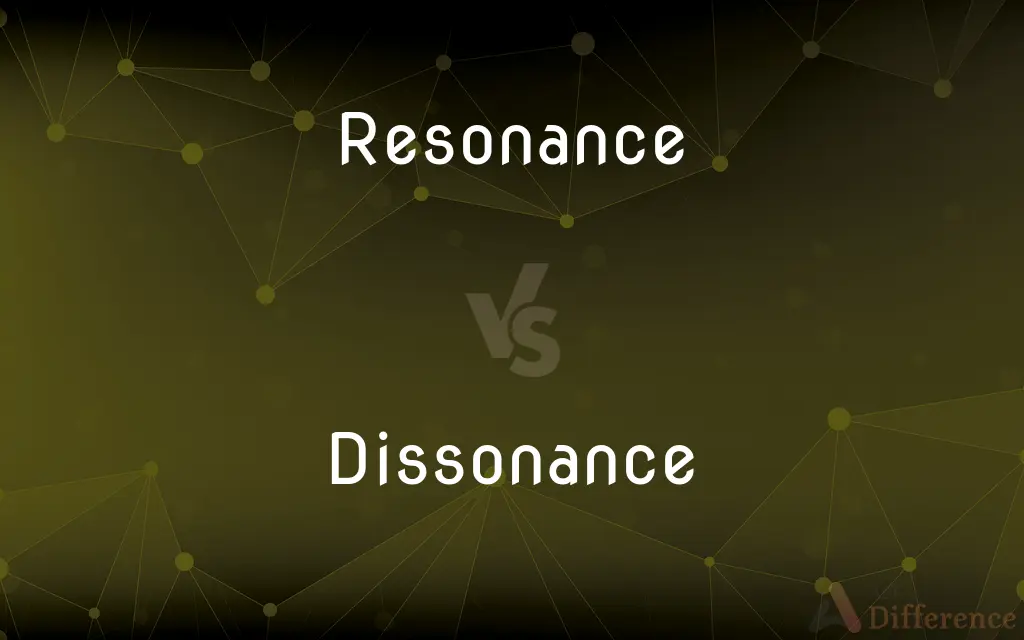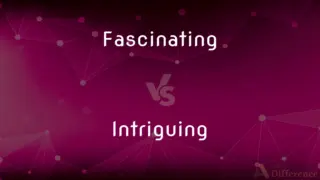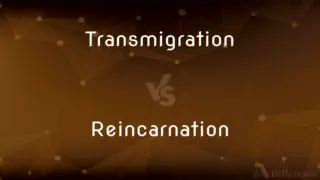Resonance vs. Dissonance — What's the Difference?
Edited by Tayyaba Rehman — By Urooj Arif — Updated on March 27, 2024
Resonance involves the amplification and enrichment of sound in harmony, often creating a pleasing effect; dissonance refers to a lack of harmony among musical notes, resulting in a tension or clash perceived as unpleasant.

Difference Between Resonance and Dissonance
Table of Contents
ADVERTISEMENT
Key Differences
Resonance occurs when a sound or vibration is reflected back, matching the natural frequency of a body or an object, thereby amplifying and enriching the original sound. This effect is often sought after in musical instruments and architectural acoustics to enhance sound quality, creating a harmonious and appealing auditory experience. In contrast, dissonance arises when two or more notes are in conflict with each other, failing to produce a harmonious blend. This clash generates a sense of tension or instability in the listener, often used intentionally in music to evoke particular emotions or to create a dramatic effect before resolving back into harmony.
The phenomenon of resonance is not limited to music; it also plays a critical role in various scientific and engineering disciplines, where it can lead to the optimization of structures and systems for better performance. For instance, resonance can enhance the efficiency of antennas, bridges, and even orbital paths in astrophysics. Dissonance, while primarily associated with music, metaphorically extends into areas of psychology and social interactions, describing situations or relationships where elements are at odds with each other, leading to discomfort or unease.
Resonance relies on the constructive interference of waves, where wave crests align to amplify the overall effect. This principle is essential in creating spaces and instruments that can carry and enrich sound effectively. Dissonance, on the other hand, results from destructive interference, where the waves' crests and troughs misalign, causing a reduction in the overall sound quality and producing a jarring effect. This concept is crucial in music theory and composition, serving as a tool for composers to manipulate emotional responses.
In practical applications, achieving resonance can significantly improve the performance and experience of sound in various contexts, from musical performances to public speaking. Designers and engineers carefully consider the properties of materials and shapes to foster resonance where it is desired. Conversely, understanding dissonance is key to avoiding unintended clashes in sound systems, building acoustics, and even in the design of public spaces where noise pollution can be an issue.
Comparison Chart
Definition
Amplification of sound through harmonious vibration.
Lack of harmony among sounds, leading to tension.
ADVERTISEMENT
Effect
Enriches and enhances sound, creating a pleasing effect.
Creates tension or clash, often perceived as unpleasant.
Application
Musical instruments, architecture, engineering.
Music theory, composition, psychological metaphor.
Principle
Constructive interference of waves.
Destructive interference of waves.
Emotional Impact
Can evoke feelings of harmony and pleasure.
Used to evoke discomfort, tension, or suspense.
Scientific Relevance
Used in optimizing structures and systems.
Metaphorically extends to conflicts and clashes.
Optimization
Enhances efficiency and performance in various fields.
Serves as a tool for emotional and artistic expression.
Wave Interaction
Wave crests align to amplify the sound.
Wave crests and troughs misalign, reducing harmony.
Compare with Definitions
Resonance
Principle used in optimizing structures for sound.
Architects study resonance to improve building acoustics.
Dissonance
Destructive wave interference reducing sound harmony.
Dissonance occurs when musical notes interfere destructively.
Resonance
Constructive wave interference enhancing sound quality.
Resonance in the concert hall allows every note to be heard clearly.
Dissonance
Clash or conflict in sound perception.
Dissonance in the symphony created an intentional feeling of suspense.
Resonance
Scientific relevance across various disciplines.
The study of resonance is crucial in developing efficient antennas.
Dissonance
Metaphor for psychological or social conflict.
The dissonance between their views led to a heated debate.
Resonance
Harmonious amplification of sound.
The violin's design optimizes resonance for richer sound.
Dissonance
Musical notes lacking harmony, creating tension.
The composer used dissonance to convey a sense of unease.
Resonance
Emotional impact evoking pleasure and harmony.
The resonance of the choir's performance left the audience in awe.
Dissonance
Tool for artistic expression and emotional manipulation.
Artists use dissonance to evoke complex emotional landscapes.
Resonance
Resonance describes the phenomenon of increased amplitude that occurs when the frequency of a periodically applied force (or a Fourier component of it) is equal or close to a natural frequency of the system on which it acts. When an oscillating force is applied at a resonant frequency of a dynamic system, the system will oscillate at a higher amplitude than when the same force is applied at other, non-resonant frequencies.Frequencies at which the response amplitude is a relative maximum are also known as resonant frequencies or resonance frequencies of the system.
Dissonance
Lack of harmony among musical notes
A session full of jangling dissonances
An unusual degree of dissonance for such choral styles
Resonance
Intensification and prolongation of sound, especially of a musical tone, produced by sympathetic vibration.
Dissonance
A harsh, disagreeable combination of sounds; discord.
Resonance
Intensification of vocal tones during articulation, as by the air cavities of the mouth and nasal passages.
Dissonance
Lack of agreement, consistency, or harmony; conflict
"In Vietnam, reality fell away and dissonance between claim and fact filled the void" (Michael Janeway).
Resonance
(Medicine) The sound produced by diagnostic percussion of the normal chest.
Dissonance
(Music) A combination of tones contextually considered to suggest unrelieved tension and require resolution.
Resonance
Richness or significance, especially in evoking an association or strong emotion
"Israel, gateway to Mecca, is of course a land of religious resonance and geopolitical significance" (James Wolcott).
Dissonance
A harsh, discordant combination of sounds.
Resonance
(Physics) The increase in amplitude of oscillation of an electric or mechanical system exposed to a periodic force whose frequency is equal or very close to the natural undamped frequency of the system.
Dissonance
(music) Conflicting notes that are not overtones of the note or chord sounding.
Resonance
(Physics) A subatomic particle having too short a lifetime to be observed directly and whose existence is inferred from a peak in the energy distribution of its decay products.
Dissonance
A state of disagreement or conflict.
Resonance
(Chemistry) The property of a compound having simultaneously the characteristics of two or more structural forms that differ only in the distribution of electrons. Such compounds are highly stable and cannot be properly represented by a single structural formula.
Dissonance
(countable) An instance of disharmony or disjunction; a clash.
Resonance
(uncountable) The quality of being resonant.
Dissonance
A mingling of discordant sounds; an inharmonious combination of sounds; discord.
Filled the air with barbarous dissonance.
Resonance
(countable) A resonant sound, echo, or reverberation, such as that produced by blowing over the top of a bottle.
Dissonance
Want of agreement; incongruity.
Resonance
(medicine) The sound produced by a hollow body part such as the chest cavity upon auscultation, especially that produced while the patient is speaking.
Dissonance
A conflict of people's opinions or actions or characters
Resonance
(figuratively) Something that evokes an association, or a strong emotion; something that strikes a chord.
Emotional resonance
Dissonance
The auditory experience of sound that lacks musical quality; sound that is a disagreeable auditory experience;
Modern music is just noise to me
Resonance
(physics) The increase in the amplitude of an oscillation of a system under the influence of a periodic force whose frequency is close to that of the system's natural frequency.
Dissonance
Disagreeable sounds
Resonance
(nuclear physics) A short-lived subatomic particle or state of atomic excitation that results from the collision of atomic particles.
Resonance
An increase in the strength or duration of a musical tone produced by sympathetic vibration.
Resonance
(chemistry) The property of a compound that can be visualized as having two structures differing only in the distribution of electrons.
Resonance
(astronomy) A influence of the gravitational forces of one orbiting object on the orbit of another, causing periodic perturbations.
Resonance
(electronics) The condition where the inductive and capacitive reactances have equal magnitude.
Resonance
(sociology) A quality of human relationship with the world.
Resonance
The act of resounding; the quality or state of being resonant.
Resonance
A prolongation or increase of any sound, either by reflection, as in a cavern or apartment the walls of which are not distant enough to return a distinct echo, or by the production of vibrations in other bodies, as a sounding-board, or the bodies of musical instruments.
Resonance
A phenomenon in which a vibration or other cyclic process (such as tide cycles) of large amplitude is produced by smaller impulses, when the frequency of the external impulses is close to that of the natural cycling frequency of the process in that system.
Resonance
An electric phenomenon corresponding to that of acoustic resonance, due to the existance of certain relations of the capacity, inductance, resistance, and frequency of an alternating circuit; the tuning of a radio transmitter or receiver to send or detect waves of specific frequencies depends on this phenomenon.
Resonance
An excited state of a stable particle causing a sharp maximum in the probability of absorption of electromagnetic radiation
Resonance
A vibration of large amplitude produced by a relatively small vibration near the same frequency of vibration as the natural frequency of the resonating system
Resonance
Having the character of a loud deep sound; the quality of being resonant
Resonance
Relation of mutual understanding or trust and agreement between people
Resonance
The quality imparted to voiced speech sounds by the action of the resonating chambers of the throat and mouth and nasal cavities
Common Curiosities
Is dissonance always undesirable?
Not always; while dissonance might be perceived as unpleasant in some contexts, it can add depth and complexity to music and art.
How do composers use resonance and dissonance?
Composers use resonance to create rich, harmonious sounds and dissonance to introduce tension or highlight emotional shifts in their compositions.
How is resonance beneficial in engineering?
In engineering, resonance can optimize structures, systems, and devices for better performance and efficiency.
What causes resonance and dissonance?
Resonance is caused by constructive interference of sound waves, while dissonance results from destructive interference.
How is resonance used in communications technology?
Resonance is used to enhance signal strength and quality in antennas, radios, and other communication devices.
How does dissonance affect the listener's emotions?
Dissonance can evoke feelings of tension, discomfort, or anticipation, often used to enhance the emotional expression of a piece.
Can resonance be dangerous?
Yes, in certain conditions, such as with bridges or buildings, resonance can cause structural damage if not properly managed.
Can dissonance be used positively in music?
Yes, dissonance is often used intentionally in music to create tension, contrast, or to evoke specific emotions before resolving to harmony.
What are examples of dissonance in everyday life?
Dissonance can be experienced in conflicting ideas, incompatible beliefs, or in the cacophony of urban environments.
What role does resonance play in architecture?
In architecture, resonance is considered to enhance the acoustics of a space, making sound more clear and pleasant.
How can dissonance be resolved in music?
Dissonance in music is typically resolved by moving to a harmonious chord or note, providing relief and resolution to the tension.
Why do some people find dissonance appealing?
Some find dissonance appealing for its ability to convey complexity, realism, and depth in music and art, challenging traditional notions of harmony.
What scientific principles underlie resonance?
Resonance is based on the principle of natural frequencies and constructive interference, where matching vibrations amplify each other.
What impact does resonance have on sound quality?
Resonance improves sound quality by amplifying and enriching the sound, making it more full and vibrant.
Share Your Discovery

Previous Comparison
Fascinating vs. Intriguing
Next Comparison
Transmigration vs. ReincarnationAuthor Spotlight
Written by
Urooj ArifUrooj is a skilled content writer at Ask Difference, known for her exceptional ability to simplify complex topics into engaging and informative content. With a passion for research and a flair for clear, concise writing, she consistently delivers articles that resonate with our diverse audience.
Edited by
Tayyaba RehmanTayyaba Rehman is a distinguished writer, currently serving as a primary contributor to askdifference.com. As a researcher in semantics and etymology, Tayyaba's passion for the complexity of languages and their distinctions has found a perfect home on the platform. Tayyaba delves into the intricacies of language, distinguishing between commonly confused words and phrases, thereby providing clarity for readers worldwide.














































